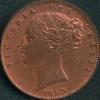If only it was that clear cut...it seems this topic always gets dragged down to a level that is too simplistic. I agree that a "two pronged trident" or a "filled 2" might not be a "variety" as we typically define one. But what does constitute a variety? It is not that easy a question to answer when you try and establish a set of rules that apply across a series/denomination. Are the punctuation differences in the James I and Charles I farthings a true variety? How about the Charles II pattern farthings, where legend position is the indicator. The varieties of 1881H farthing which are predominantly established through the style/position of the H. Would the "rounded top" lighthouse variety of 1881H farthing be worthy of inclusion? Why are we happy to define a minor tweak to the main design, a grained edge, a change in alignment or material used as a type or variety, but if the same thing happens in relation to other aspects, such as the legend or date it is dismissed so easily. When does a different strike material become an error or a different type? It is a subject that is a lot more complicated than people think at first glance. When you actually try and catalogue a list of varieties, using a defined set of parameters it becomes exceedingly difficult. I am not saying that anyone is necessarily right or wrong, but I would always be willing to listen to someone's opinion and read how or why they established the parameters they have before dismissing it as not following the "norm" It is often by studying these features that additional knowledge on die sequencing and coin production/design becomes apparent. Defining the two Reverse designs for the copper Victorian Farthing series was only possible through cataloging and studying the design intensively and establishing a recurring pattern. Any of the individual features allocated to the identification could have been dismissed as being insignificant reworking of the dies, however as a collective group of features they help establish a new design type.
 Coinpublications.com
Coinpublications.com

